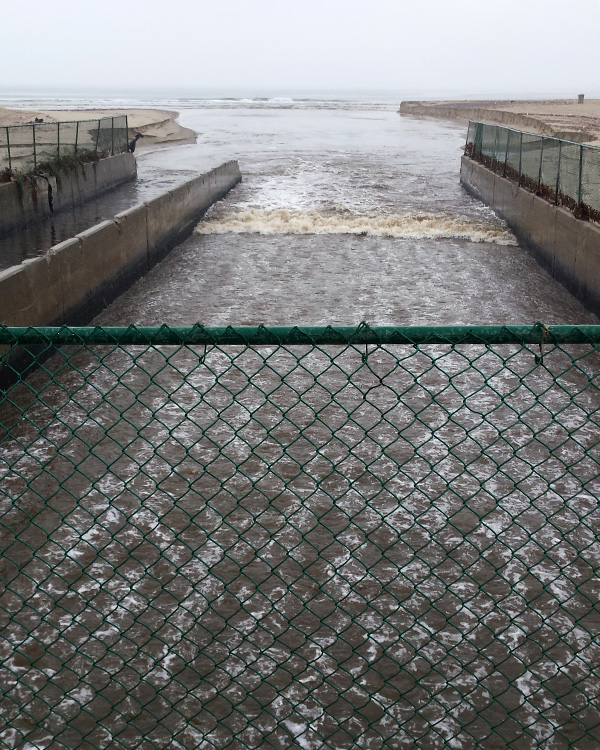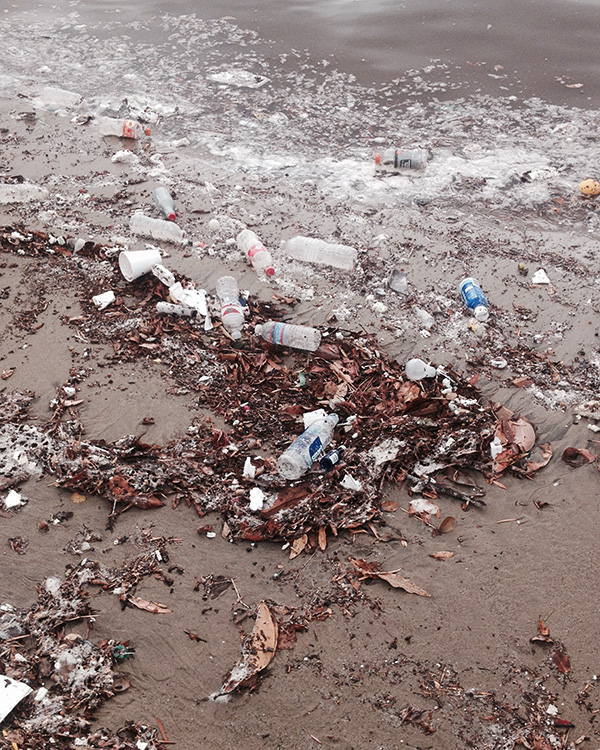Look What the Storm Dragged In!
Yes, we needed last night’s sporadic but intense rainfall. But it left a lot of waste – both literally and figuratively — says Matthew King, Heal the Bay’s communications director.
Sept. 15, 2015 — Welcome to Bay Street, where the trash meets the surf!
After last night’s deluge, I took a reconnaissance trip this morning to Santa Monica’s Pico Kenter storm drain, which drains directly into my regular surf spot. As the pictures below attest, there was no shortage of plastic bags, water bottles, fast food packaging, balloons and bits of Styrofoam to be found after the storm. Even if you don’t surf here, it’s a disturbing sight. (Check out the videos at bottom of this post for real-time views.)
During the so-called “First Flush,” trash and toxins that have been accumulating for months on sidewalks, roadways and riverbeds wash into L.A. County’s extensive stormdrain system. After a big storm like last night’s, more than 10 billion gallons of polluted water enters the Bay.
 |
 |
 |
As you read this, more than 70 major outfalls in L.A. County are spewing debris, animal waste, pesticides, automotive fluids and human-gastrointestinal viruses into the sand and sea. Major yuck! This pollution poses human health risks, harms marine life and hurts our $20 billion coastal economy.
Exposure to this runoff can also make you really sick, most frequently with stomach flu. For that reason, Heal the Bay urges people to avoid water contact at Los Angeles County beaches for 72 hours following rainfall. Recent studies suggest five days would be more appropriate at storm drains like Pico Kenter.
With more tropical heat forecast throughout the week, we’re concerned that beachgoers will jump back into the ocean sooner than advisable. They may be looking to catch a few waves, but could catch a nasty bug instead. So please stay out of the water the next few days!
There’s another equally disturbing aspect to the runoff – it’s a huge waste of water!
Los Angeles imports costly and increasingly scarce water from Northern California and the Colorado River. We now import more than 80% of our water, using enormous amounts of energy to do so.
Stormwater — if held, filtered and cleansed naturally in groundwater basins — could provide a safe, more secure and less costly source of drinking water. That 10 billion gallons of water from an average single storm in L.A. could fill nearly 120 Rose Bowls. That would provide enough water for a city the size of Santa Monica for more than three months.
Our policy team is advocating for multi-benefit infrastructure projects that capture water onsite for reuse or recharging groundwater. Our staff scientists are working with state and local governments to find creative ways to fund stormwater programs. We hope to get funding in place before 2020. Philadelphia and Portland have done it, and so can we!
Meanwhile, there are steps you can take in your own home to take pressure off an already taxed stormdrain system. Among them:
- Keep trash out of gutters and stormdrains
- Dispose of animal waste and automotive fluids properly
- Limit runoff by curtailing such wasteful practices as hosing driveways and overwatering landscapes. (It’s already illegal to do so in many cities.)
Finally, if scenes pictured above bother you, we’ve got a couple ways that you can help out.
- Volunteer for this weekend’s Coastal Cleanup Day, our biggest volunteer event of the year. More than 10,000 ocean lovers will gather at 50 beach and inland sites to remove debris and learn about what they can do year-round to protect our shorelines.
- Become a Heal the Bay member or make a one-time donation to support our science and policy team’s work to curb plastic waste and hold polluters accountable.
- Join our elite Storm Response Team, a group of committed trash-busters who swarm our most troubled beaches on 24 hours’ notice.


